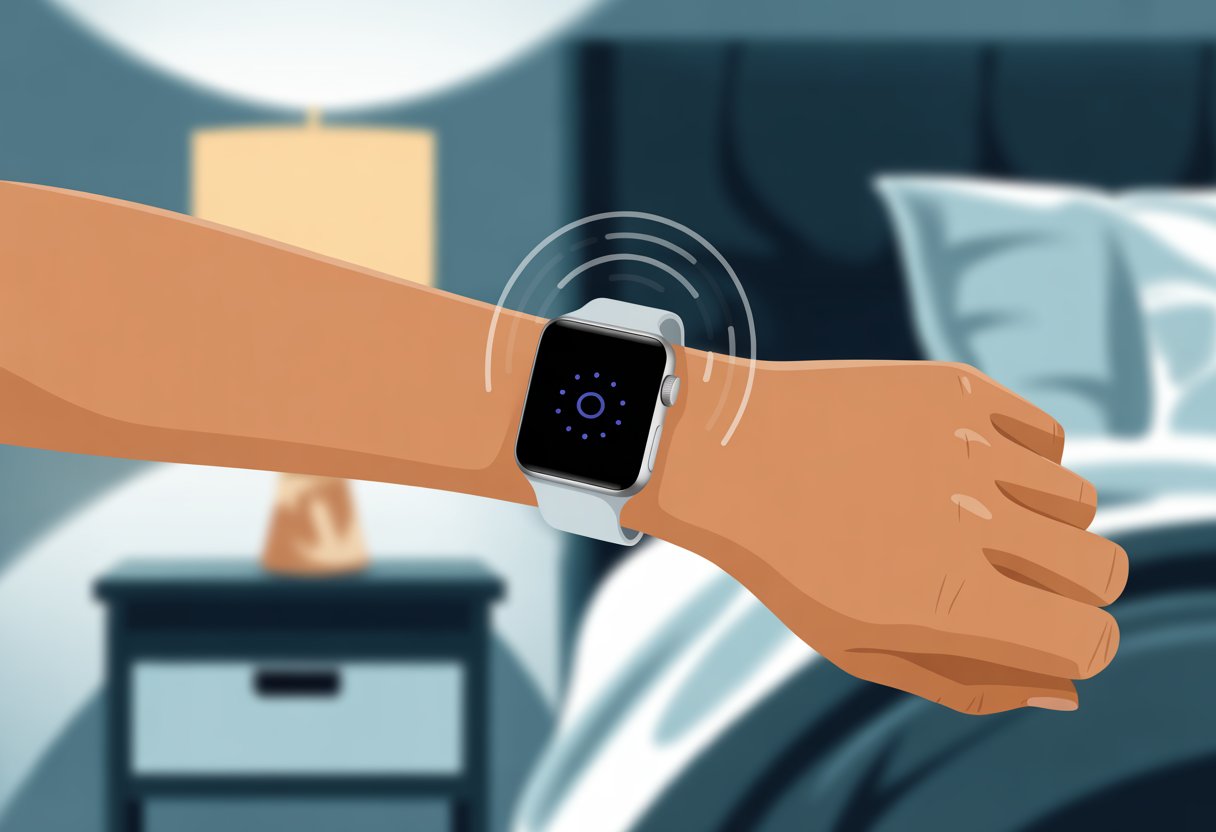Let’s be real—nobody enjoys starting their day with a blaring, heart-stopping alarm. Luckily, with trusty smartwatches, silent alarms are here to save the morning (and maybe our relationships too). We can set a vibrating alarm on our smartwatch so we wake up quietly—no angry roommates, no startled pets. Peaceful mornings actually feel possible now.

Using silent alarms on a smartwatch is pretty straightforward and doesn’t bother anyone else. Brands like Samsung, Apple, and Fitbit make it easy to set up these gentle reminders right on our wrists.
Learning to master this quiet tech lets us sneak out of bed without becoming public enemy number one. Honestly, it feels a bit like having a secret superpower.
Ready to make mornings less painful and keep the peace at home? Let’s see how our wrist can do the waking up, while everyone else keeps snoozing.
Getting Started With Silent Alarms on Your Smartwatch
Silent alarms are awesome for waking us up, reminding us about tasks, or just keeping our day on track—without the obnoxious noise. Instead, our wrists just buzz a little and let us know what’s up, so the only thing we might disturb is our cat.
Setting Up Vibrations Instead of Sounds
First, we need to poke around the alarm settings on our smartwatch. Most smartwatches give us a vibration option for alarms.
So, instead of an annoying beep, our watch just gives us a gentle buzz—enough to wake us, but not enough to make us jump out of our skin.
Setting these alarms usually means:
- Opening the alarm app
- Picking a time
- Flipping on a “vibration” or “silent” toggle
Some smartwatches—like the Fitbit Versa and Ionic—make this super simple. We just tap “silent” or “vibration,” confirm the time, and we’re set.
On certain models, we can even set repeating alarms if we need a little extra help getting up. If we’re feeling fancy, some smartwatches let us tweak the vibration type or strength.
So, whether we want a soft nudge or a full-on wrist massage, it’s up to us.
Pairing With Your Phone Using Bluetooth
For our silent alarm to actually work, we usually need to pair our smartwatch with our phone via Bluetooth. This connection keeps alarm times, health data, and notifications in sync, so our watch is always up to date.
Here’s what pairing looks like:
- Turn on Bluetooth on both the phone and smartwatch.
- Open the companion app for our watch (like the Fitbit app or Samsung Wearable).
- Follow the prompts to start pairing.
Pairing also unlocks extras—we can set alarms remotely or tweak settings from our phone. Some models—like Samsung and Garmin—rely on apps for most tweaks, so Bluetooth pairing is pretty important for all the silent mode features.
If pairing doesn’t work, just reboot both devices. It’s basically the tech world’s version of “have you tried turning it off and on again?”
Setting Up and Customizing Your Silent Alarm
If loud alarms make us public enemy number one, a smartwatch can save the day with silent alerts that just vibrate. We get control over alarm settings, can pick favorite apps, and set reminders for almost anything.
Adjusting Alarm Settings for Stealth Mode
Let’s get sneaky. We’ll jump into the alarm settings on our smartwatch.
Most watches have a “Silent” or “Vibrate Only” mode. On many devices, switching to stealth mode just means toggling silent mode and turning on vibration.
For example, on the Apple Watch, we can set an alarm, press the side button, and enable Silent Mode with Prominent Haptics for a stronger buzz.
If we’re heavy sleepers, short, repeatable alarms help—no shame in needing a wake-up call that feels like a tiny earthquake. Most smartwatches let us set multiple or repeating alarms, so we don’t have to mess with menus every morning.
Need a discreet reminder in a meeting or boring dinner? Set a reminder and keep your secrets safe.
Choosing the Right App for Alarms and Reminders
Not all alarm apps are equal. Some just vibrate, others offer silent timers and reminders with bonus features.
We should check the app store and look for alarm or reminder apps that support silent or haptic-only alerts. Apple Watch users can stick with the built-in Alarms app, while Fitbit users get a simple alarm setup screen.
If we’re using a less-known smartwatch, we might need to dig for a third-party app or use the default reminder function—those usually vibrate too. For tracking fitness or habits, some apps like VeryFitPro let us set special alerts, all using silent alarms.
We can read more about options for Apple Watch and other devices to find what works for our sneaky needs.
Maximizing Battery Life With Silent Alarms
If we count on our smartwatch to wake us up quietly, we need the battery to last more than a day. With a few tweaks, we can keep our wrists—and our sanity—charged up.
Optimizing Notification Settings
Every ping, buzz, or emoji on our wrist eats up battery. If we let every app send alerts, our battery will beg for mercy by lunchtime.
Let’s be picky. We can turn off notifications for apps that aren’t urgent.
Only alarms or important messages should get through. This is easy—just head into notification settings on the watch or its phone app.
We can also reduce vibration strength if possible. A gentle nudge does the trick without draining power.
Some watches let us turn off Always-On Display and background app refresh, which helps with battery life. Adjusting these settings means our smartwatch might actually last as long as our sleep schedule.
For more battery-saving tips, check out this advice on long battery life and notifications.
Using Smartwatch Sensors to Enhance Your Alarm Experience
Smartwatch sensors do more than just buzz us awake. They use heart rate and movement data to make waking up smoother (and less annoying for everyone else).
Monitoring Sleep Stages With Heart Rate Data
Smartwatches track our sleep by recording heart rate and movement through the night. Some watches figure out which sleep stage we’re in—light sleep, deep sleep, or maybe that weird dream where we’re late for class.
This info helps the watch pick the best time to wake us up. If we set a window—say, between 7:00 and 7:30 AM—the watch tries to buzz when our body’s most ready, not when we’re in the middle of a wild dream.
Our heart rate shifts during different sleep stages. A smart alarm uses these changes to wake us up gently.
Instead of feeling like we got hit by an airhorn, we get a slow, pleasant vibration out of dreamland.
Some devices support smart alarms, including tracking sleep cycles with sensors. We wake up less groggy, and our families probably appreciate our better moods.
Why Your Watch’s Sensor Is Smarter Than You Think
Let’s give some credit to smartwatch sensors. They don’t just randomly pick a time—they analyze heart rate, motion, and sometimes even oxygen levels. That’s more than most of us manage before coffee.
With sensors running all night, our watch learns our sleep habits. If we toss, turn, or our heart races from a wild dream, the watch uses that info to customize our alarm.
It’s like having a sleep coach on our wrist—no whistle needed. Some watches even learn our routines and adjust vibration strength so we notice the alarm, but whoever’s next to us doesn’t.
We can thank clever sensors in smartwatches for making wake-up calls private and on point—no trumpet required.
Tips for Comfortable Wear During Silent Alarming
Wearing a smartwatch for silent alarms shouldn’t feel like medieval wrist armor. We want comfort, durability, and something that won’t leave us sweaty at 3 a.m.
The right strap makes it easier to sleep and wake up without hating our gadgets.
Selecting a Silicone Strap for Night-Time Comfort
Let’s face it: metal bands and leather straps sound fancy until we try sleeping in them. Silicone straps win at night because they’re soft, flexible, and don’t turn into mini-saunas while we snooze.
We should look for straps that are hypoallergenic and breathable—nobody likes waking up with wrist marks that look like ancient symbols.
It’s smart to pick a strap with enough adjustment holes. That way, we get a snug (but not too tight) fit that stays put while we toss and turn.
If our smartwatch vibrates like a caffeinated bumblebee, a silicone strap helps cushion the alarms so they wake us up but don’t shake our whole arm.
And, bonus, silicone is easy to clean if we drool in our sleep (hey, it happens). For more comfort ideas, some silent alarm watches use smooth, cool materials just for sleeping.
Setting Multiple Clocks and Reminders Without Awaking the Whole Neighborhood
We all want to wake up on time and remember important stuff, but nobody wants to be the reason the whole block needs extra coffee.
Smartwatches let us manage our lives quietly, so the rooster (and our family) can keep sleeping.
Managing Several Alarms for Maximum Efficiency
Setting up more than one alarm on a smartwatch feels a bit like hiring a team of tiny, silent butlers. You can add alarms for different times, tasks, or events.
Most smartwatches let you create multiple silent alarms that vibrate on your wrist instead of blaring like a fire drill. For example, Fitbit lets you set up to 15 individual silent vibrating alarms.
With several alarms, you don’t have to worry as much about sleeping through that one crucial beep. The Apple Watch and other brands let you pick vibrate only or sound and vibrate, so your sleeping pets won’t judge your 6 a.m. routine.
Adding or editing alarms usually just takes a few taps. Honestly, it’s way easier than fiddling with those old-school alarm clocks.
Pro Tip:
- Give each alarm a clear label.
- Spread them out—unless you enjoy a rapid-fire buzz session.
- Check your alarms every week so you don’t get reminded about last Thursday’s homework.
Using Reminders to Outsmart Forgetfulness
Reminders on smartwatches help us stay on track—no blaring alarms, no sticky notes cluttering the fridge. When we set a reminder, our wrist just gives a gentle nudge instead of a table-shaking alarm. That’s honestly a lifesaver for things like remembering to water the plants or, maybe, finally calling Grandma.
We can use apps or just talk to our watch to set reminders, depending on what we’ve got. Apple Watch and Wear OS both let us type or speak what we need. If you’re the type who likes a little more control, you can set daily, weekly, or custom reminders.
Here’s something we wish we knew sooner: some watches only vibrate if you set reminders through their own app. We definitely missed a snack break or two before figuring that out.
Reminder Settings Checklist:
- Set reminders at least 5 minutes before you need to do something.
- Use vibration-only if you want a quiet alert.
- Double-check if your voice-set reminders actually vibrate, because as some users mention, weird settings can mess things up.
With smartwatches, we can leave the noisy alarms to cartoons and keep our mornings (and forgetful moments) a little more peaceful.
- Why do my Bluetooth headphones keep resetting? Solving the Mystery of Rebooting Ears - January 5, 2026
- Is WHOOP Worth It for Runners, Cyclists, and Weightlifters or Just Another Expensive Wrist Buddy? - January 5, 2026
- Best Fitness Trackers Under $200 That Won’t Make Your Wallet Sweat - January 4, 2026






